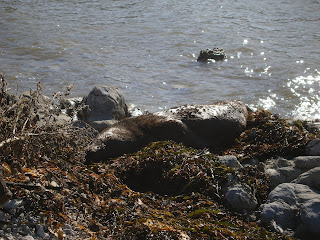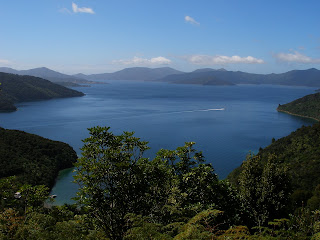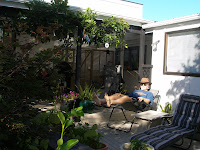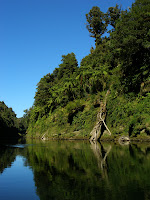










Kaikoura : Mountains and Mammals
Kaikoura was a wonderful place to rest and soak up the scenery in a relaxed way ,after our rather strenuous hike. The little town is picturesque, on a penninsula that juts out to sea with huge white capped mountains in the background. It was a sleepy fishing village until 1987 when whale watch charters started its first whale watching operation, and now it's a huge tourist mecca because of the whales. The continental shelf here drops steeply from 75 metres to over 3000 metres in a short distance, and two currents one warm and one cold converge here, making it a favorite site for whales, particularly the sperm whale, which hunts in a solitary fashion, often diving up to 1 mile in depth to feed. We had a great view of 2 sperm whales on our adventure, even seeing the characteristic upturned tail when they dove down. We also saw a blue shark, and some albatrosses. The town is also home to several seal colonies. We had great view of the seals on our first day at low tide. On the second day, at high tide we saw the seals up close and personal, about 10 ft away, sleeping on the grass under bushes and even on the pavement in the carpark- totally oblivious to the tourists.
On our last day, we had the opportunity to go to the Kaikoura A&P show ( or agricultural and pastoral show)- a bit like a smaller version of Western Fair-or maybe the Ilderton Fair. The highlight for us was seeing the sheep shearing competitions. Three contestants at a time would shear, trying to be the fastest and the most accurate. The senior shearers were headed for the world championships - the winner could shear 800 sheep in a 9 hour day- impressive! The excitement just grew when we got to see a real dog and pony show. Kids in carts raced ponies- one pony being significantly larger than all the others ( maybe on roids?). The dog races were priceless. The terriers got all suited up in their racing outfits with numbers; they lined up at the start with some difficulty, then a sheepskin on a retractable rope was released and they were off One pup just couldn't get the hang of the competition and was still wandering on the track after all the other dogs had left .Daisy would have loved it.
Our last morning we said goodbye to our wonderful accomodation - a century old cottage called the red door cottage, watched a great sunrise and headed off. We were a bit unnerved when we were driving the coastal road with the sea on one side and the mountains on the other, to see a train pulling up behind us, and overtaking. The Tranz Scenic Railway track runs parallel to the highway for several miles. At one point the people in the observation car were taking photos of the sea, as I was taking pictures of their train. We passed lots of vineyards in Blenheim and Renwick, passed the green lipped mussel capital of the world in Havelock , and after much winding up mountain roads, arrived at our new home in Nelson.
Kaikoura was a wonderful place to rest and soak up the scenery in a relaxed way ,after our rather strenuous hike. The little town is picturesque, on a penninsula that juts out to sea with huge white capped mountains in the background. It was a sleepy fishing village until 1987 when whale watch charters started its first whale watching operation, and now it's a huge tourist mecca because of the whales. The continental shelf here drops steeply from 75 metres to over 3000 metres in a short distance, and two currents one warm and one cold converge here, making it a favorite site for whales, particularly the sperm whale, which hunts in a solitary fashion, often diving up to 1 mile in depth to feed. We had a great view of 2 sperm whales on our adventure, even seeing the characteristic upturned tail when they dove down. We also saw a blue shark, and some albatrosses. The town is also home to several seal colonies. We had great view of the seals on our first day at low tide. On the second day, at high tide we saw the seals up close and personal, about 10 ft away, sleeping on the grass under bushes and even on the pavement in the carpark- totally oblivious to the tourists.
On our last day, we had the opportunity to go to the Kaikoura A&P show ( or agricultural and pastoral show)- a bit like a smaller version of Western Fair-or maybe the Ilderton Fair. The highlight for us was seeing the sheep shearing competitions. Three contestants at a time would shear, trying to be the fastest and the most accurate. The senior shearers were headed for the world championships - the winner could shear 800 sheep in a 9 hour day- impressive! The excitement just grew when we got to see a real dog and pony show. Kids in carts raced ponies- one pony being significantly larger than all the others ( maybe on roids?). The dog races were priceless. The terriers got all suited up in their racing outfits with numbers; they lined up at the start with some difficulty, then a sheepskin on a retractable rope was released and they were off One pup just couldn't get the hang of the competition and was still wandering on the track after all the other dogs had left .Daisy would have loved it.
Our last morning we said goodbye to our wonderful accomodation - a century old cottage called the red door cottage, watched a great sunrise and headed off. We were a bit unnerved when we were driving the coastal road with the sea on one side and the mountains on the other, to see a train pulling up behind us, and overtaking. The Tranz Scenic Railway track runs parallel to the highway for several miles. At one point the people in the observation car were taking photos of the sea, as I was taking pictures of their train. We passed lots of vineyards in Blenheim and Renwick, passed the green lipped mussel capital of the world in Havelock , and after much winding up mountain roads, arrived at our new home in Nelson.








































